- 1College of Agriculture, Northeast Agricultural University, Harbin, China
- 2Institute of Maize Research, Heilongjiang Academy of Agricultural Sciences, Harbin, China
- 3Institute of Crop Cultivation and Tillage, Heilongjiang Academy of Agricultural Sciences, Harbin, China
- 4Institute of Crop Science, Chinese Academy of Agricultural Sciences, Beijing, China
High-density planting aggravates competition among plants and has a negative impact on plant growth and productivity. Nitrogen application and chemical control can improve plant growth and increase grain yield in high-density planting. Our experiment explored the effects of nitrogen fertilizer and plant growth regulators on maize root-bleeding sap, phosphorus (P) and potassium (K) accumulation and translocation, and grain yield and quality in high-density planting. We established a field study during the 2017 and 2018 growing seasons, with three nitrogen levels of N100 (100 kg ha−1), N200 (200 kg ha−1), and N300 (300 kg ha−1) at high-density planting (90,000 plants ha−1), and applied Yuhuangjin (a plant growth regulator mixture of 3% DTA-6 and 27% ethephon) at the 7th leaf. Our results showed that N200 application combined with chemical control could regulate amino acid and mineral nutrient concentration delivery rates in root-bleeding sap and improve its sap rate. Also, the treated plant exhibited higher P and K uptake and translocation ability. Furthermore, chemical control and N200 treatment maintained a high level of ribulose-1,5-bisphosphate carboxylase (RuBPCase), phosphoenolpyruvate carboxylase (PEPCase), nitrate reductase (NR), and glutamine synthetase (GS) enzymatic activities in leaves. In addition, plant growth regulator and nitrogen application improved the enzymatic activities of GS, glutamate dehydrogenase (GDH), and glutamic pyruvic transaminase (GPT) and the contents of crude protein, lysine, sucrose, and soluble sugar in grain and ultimately increased maize yield. This study suggests that N200 application in combination with chemical control promotes root vitality and nutrient accumulation and could improve grain yield and quality in high-density planting.
Introduction
The root is an essential absorption system, and its function is to maintain the supply of nutrients and soil moisture for crop growth and development (Xu et al., 2009; Fan et al., 2021). The root system of crops greatly influences the above-ground growth and biomass yield, which play an important role in yield formation (Yang et al., 2004; Chen et al., 2022). The capacity for nutrient and soil moisture uptake by crops is directly influenced by root development and root activity strength (Li et al., 2019). Well-developed root systems are always accompanied by vigorous above-ground growth and high yields. Root-bleeding sap is a sign of root pressure, and its change is consistent with root activity (Xu et al., 2016). The root-bleeding sap is directly correlated to the uptake of nutrients and water and reflects the root system's potential for plant growth and root activity (Ansari et al., 2004; Noguchi et al., 2005). The concentration of nutrients in root-bleeding sap represents the nutritional status and reflects root absorption and translocation rates in crops (Noguchi et al., 2005; Nishanth and Biswas, 2008). Hence, an appropriate rate of root-bleeding sap is vital to optimizing maize yield and directly influencing maize growth and development.
Nutrient absorption and translocation in crops are the physiological basis for dry matter accumulation and yield formation, influencing crop growth and development (Wu et al., 2018; Li et al., 2021). The difference in biomass yield is closely correlated to the plant's nutrient uptake and utilization characteristics. It is generally believed that obtaining a higher yield requires crops to absorb a large amount of nutrients from the soil (Wu et al., 2015; Zhan et al., 2016). Phosphorus promotes carbohydrate and starch synthesis in stems and leaves and increases the nutrient transport to the grains, thereby improving grain weight and quality (Wang and Ning, 2019). Potassium can stimulate the synthesis and transport of carbohydrates and promote the growth of maize ear (Shahzad et al., 2017). Phosphorus and potassium are nutrient elements in great demand for maize. Adequate P and K supply promotes root development and dry matter accumulation and enhances maize's resistance to stress (Xie et al., 2011; Iqbal et al., 2020). Furthermore, maize's adequate P and K contents promote the grain development process and help in obtaining a relatively high grain number per ear and weight (Liu et al., 2011). Therefore, the absorption and translocation of P and K play an important role in maize growth and yield potential in the process of yield formation.
Maize (Zea mays L.) is one of the most essential cereal feeds worldwide and occupies a prominent place in global food security and sustainable development (Palacios-Rojas et al., 2020). Since the mid-1990s, with the improvement of the economy and dietary structure in China, the consumption of animal-derived foods, such as meat, milk, and eggs, has increased, which rapidly increased the demand for maize. Maize is the most widely cultivated crop in China, and its production reflects people's need (Liu S. Q. et al., 2021). Northeast China is a major maize producing region, and its planting area and yield account for 31 and 34%, respectively, of the total maize production in China (Liu and Ye, 2020). The current maize planting density in Northeast China is relatively low, resulting in fewer grain yields (Luo et al., 2020). Maize yield in this region has only reached 50% of its yield potential, which offers an excellent opportunity for increasing yield. It is generally accepted that relying on high-density planting to enhance population productivity is one of the most important measures to increase yield potential (Tang et al., 2018). However, high-density planting increases resource competition among maize plants, leading to a decline in individual plant productivity and negatively affecting yield potential (Rossini et al., 2011). This inevitably intensifies the competition betwen the root systems as it is an important organ for maize to obtain environmental resources. Increased planting density leads to decreased row spacing, resulting in increased nutrients, water, and space competition between maize plants. It also severely limits the spatial distribution of the root system and restricts the capacity of nutrient absorption and utilization, ultimately leading to a decline in root quality and grain yield (Gao et al., 2021). According to Shao et al. (2018), root length and root number per plant decrease significantly as planting density increases. The increase in planting density not only inhibits the growth, quantity, and quality of maize roots but also reduces nutrient absorption and translocation in maize (Li et al., 2020; Gao et al., 2021). Therefore, enhancing root physiological characteristics and nutrient absorption capacity in high-density planting for optimal maize growth and high yield has become a significant problem in maize production.
A sufficient supply of nutrients has become essential to achieving high crop yield under high-density planting. Nitrogen, one of the most critical nutrient elements during the maize growing period, greatly affects the root morphological characteristics and physiological activities (Li et al., 2019). It is reported that nitrogen application could significantly increase the total length, volume, and effective absorption area of roots, thereby improving root nutrient absorption capacity (Liu et al., 2017). Furthermore, nitrogen fertilizer plays an important role in the crop's nutrient accumulation and transport activity. Appropriate nitrogen application can increase the grain yield by increasing nutrient accumulation post-anthesis and nutrient translocation to grains (Zhang et al., 2021). Chemical control is one of the efficient cultivation measures, which regulates plant growth and development process, enhances nutrient utilization capacity and environment adaptability, and improves grain yield and quality (Hutsch and Schubert, 2017; Stutts et al., 2018). The application of plant growth regulators can enhance the capacity of crops to absorb nutrients and soil moisture by improving their root growth characteristics (Lin et al., 2019; Nawaz et al., 2020). Yuhuangjin is a type of plant growth regulator that is widely used in maize production in China. The main component is ethephon and diethyl aminoethyl hexanoate DTA-6, which improves plant growth, enhances lodging resistance, optimizes yield component, and increases yield (Zhang et al., 2014). Therefore, we hypothesized that chemical control and nitrogen fertilizer could improve root growth, increase nutrient absorption, and promote yield formation in maize. To prove this hypothesis, this study investigated the effects of chemical control and nitrogen fertilizers on root-bleeding sap characteristics, P and K accumulation and translocation, and grain yield and quality in high plant density. This study aimed to provide a theoretical basis for increasing maize yield and quality in future high-density planting management practices.
Materials and Methods
Site Description
The experiment was conducted from April to September in 2017 and 2018 at the experimental station of Northeast Agricultural University, Harbin, Heilongjiang Province, China (126°54′E, 45°46′N). The region has a typical warm temperate monsoon climate with an annual mean temperature of 4.5°C and annual mean precipitation of 569 mm. The crop rotation system is continuous maize cropping, and the soil type at the experimental site is chernozem. The physical and chemical characteristics of tillage layer soil were pH 6.85; organic matter 25.25 g kg−1; total nitrogen 1.70 g kg−1; available phosphorus 65.34 mg kg−1; and available potassium 179.35 mg kg−1. Temperature and rainfall during the growth stage of spring maize in 2017 and 2018 are shown in Figure 1.
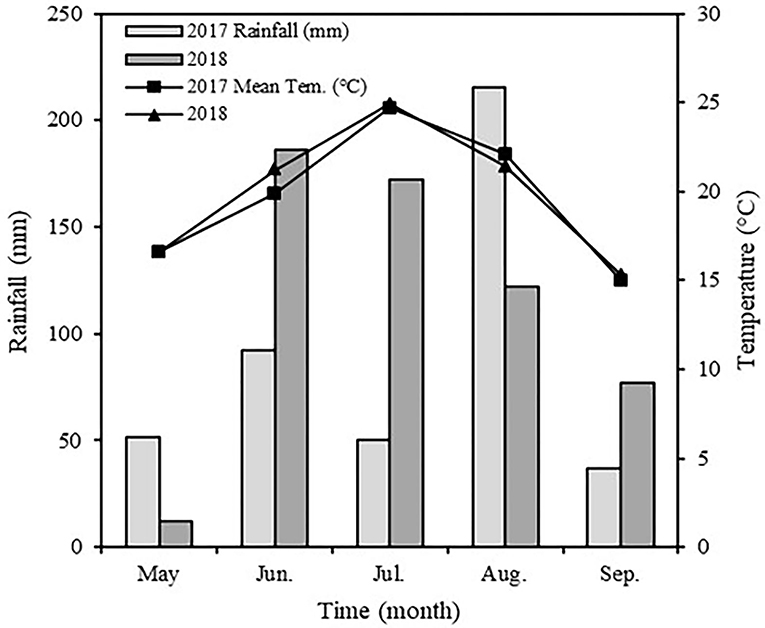
Figure 1. Monthly rainfall distribution and mean temperature during spring maize growing stage in 2017 and 2018.
Experimental Design and Field Management
The experiment was laid out as a split-plot design with three replicates. Two chemical treatments (Y, Yuhuangjin; Control (CK), water) were used as the main plots, and three nitrogen fertilizer levels were used as the subplots: 100 kg ha−1 (N100), 200 kg ha−1 (N200), and 300 kg ha−1 (N300). The plant growth regulator Yuhuangjin (the mixture of 3% DTA-6 and 27% ethephon) was provided by Haolun Co., Ltd., Fujian, China. About 0.83 mL L−1 of Yuhuangjin solution was sprayed on the foliar surface at the seven-leaf stage in the afternoons between 16:00 and 18:00 h. Yuhuangjin was applied at 450 L ha−1, and the same volume of water was applied to the control plants. Spring maize Longyu 365, a high-yielding variety in Heilongjiang province, was sown manually at 90,000 plants ha−1 on 30 April and harvested on 25 September in 2017 and 2018. The size of each plot was 5.2 × 8 m with 0.65 m row spacing. All plots were supplied with 100 kg ha−1 P2O5 and 100 kg ha−1 K2O. The total phosphorus and potassium and half of the nitrogen (urea, 46% N) were applied at the sowing. The balance half of the nitrogen was applied at the jointing stage. No irrigation was applied during the maize growing season. Pests, weeds, and diseases were controlled in a timely manner, and tillage management was conducted according to local farmer management.
Collection of Root-Bleeding Sap
Three representative plants were sampled from each plot at jointing, tasseling, early grain filling, and milking stages. The plants were cut at the third basal internode using lopping shears at 19:00 h. The incision was washed with distilled water, covered with a centrifuge tube containing degreasing cotton (≈2/3 of the centrifugal tube volume), and secured with plastic wrap to collect the root-bleeding sap. The centrifuge tubes were collected at 6:00 h the next day, and the weight was measured (Wang H. et al., 2019). The bleeding sap rate was calculated as the weight increase of the centrifuge tube per hour per plant (g h−1 plant−1).
Analysis of Root-Bleeding Sap Components
Concentrations of serine (Ser), glutamic acid (Glu), glycine (Gly), alanine (Ala), valine (Val), lysine (Lys), methionine (Met), arginine (Arg), and leucine (Leu) in the root-bleeding sap were measured using high-performance liquid chromatography with pre-column derivatization (Li H. W. et al., 2012). Concentrations of P, K, Ca, Mg, Fe and Zn were measured using inductively coupled plasma optical emission spectroscopy (ICP-AES, OPTIMA 3300 DV, Perkin-Elmer, USA).
Determination of Photosynthesis and N Metabolism Enzyme Activities in Ear Leaf
Approximately 0.5 g of fresh ear leaf was homogenized with an extraction medium (pH 8.4, 0.1 mmol L−1 Tricine-HCl, 10 mmol L−1 MgCl2, 1 mmol L−1 EDTA, 7 mmol L−1 β-mercaptoethanol, 5% glycerol (v/v) and 1% PVP) in an ice-cold mortar with a pestle. The homogenate was centrifuged at 15,000 × g for 10 min at 4°C. The supernatant was used for the RuBPCase and PEPCase assays following the methods of Lilley and Walker (1974) and Arnozis et al. (1988), respectively.
Approximately 1 g of fresh ear leaf was homogenized with the extraction medium (pH 7.5, 0.1 mol L−1 Tris-NaOH, 5 mmol L−1 MgCl2 and 1 mmol L−1 DTT) precooled in ice, followed by centrifugation at 20,000 × g for 15 min at 4°C. The supernatant was used for enzyme assays. Nitrate reductase (NR) activity was determined by the method of Lewis et al. (1982), and glutamine synthetase (GS) activity was determined by the method of Canovas et al. (1991).
Determination of N Metabolism Enzyme Activity in Grain
Three ears per plot were randomly sampled at 10, 15, 20, 25, and 30 days after silking. Approximately 100 grains in the middle of the ear were collected and frozen in liquid N2 and stored at −80°C for enzyme assays. About 0.5 g of frozen grain was homogenized with phosphate buffer (pH 7.2), followed by centrifugation at 10,000 × g for 20 min. The supernatant was used for enzyme assays of GS and glutamate dehydrogenase (NADH-GDH and NAD-GDH) activities following the method of Wang et al. (2016).
About 0.2 g of frozen grain was homogenized with Tris-HCl extraction buffer (pH 7.2, 50 mmol L−1 trihydroxymethyl aminomethane) precooled in ice, followed by centrifugation at 20,000 × g for 20 min at 4°C. The supernatant was used for the glutamic-pyruvic transaminase (GPT) assay following the method of Wang et al. (2016).
Analysis of Nutrients Concentration in Grain
The grains were sampled and oven-dried at 40°C for 24 h and ground to powder at harvest. The resulting grain powder was passed through a 0.25 mm mesh and stored at 4°C for analysis. Crude protein in grain was assayed by the micro-Kjeldahl method described by the Association of Official Agricultural Chemists AOAC (1975). Crude fat was assayed following the method of AOAC (1984). Starch was assayed by the colorimetric method described by Boros et al. (2004). Lysine was assayed using the colorimetric method described by Reddy et al. (2013).
Approximately 1 g of fresh grain was ground in a mortar with liquid nitrogen, and 10 ml of distilled water was added to the sample and incubated in boiling water for 60 min. The mixture was centrifuged at 12,000 × g for 20 min at 4°C. The supernatant was used for soluble sugar and sucrose measures. Soluble sugar was measured by the anthrone colorimetric method described by Liu et al. (2007). Sucrose was measured by the anthrone method described by Van (1968).
Determination of P and K Accumulation and Translocation
Three plants were sampled from each plot and separated into stems, leaves, and grains during harvest. The samples were dried in an oven at 105°C for 30 min and afterward at 80°C to a constant weight. Dried samples were weighed and ground to pass through a 1-mm sieve and digested by an H2SO4-H2O2 mixture (Wolf, 1982). The P concentration was determined by the ammonium molybdate ascorbic acid reduction method (Murphy and Riley, 1962). The K concentration was determined by the flame photometer method. Nutrient (P or K) accumulation was calculated based on the sum of the dry matter and P or K concentration in plant parts.
Nutrient (P or K) translocation amount of pre-silking (TAE, kg ha−1) = vegetative organ nutrient (P or K) content at silking—vegetative organ nutrient (P or K) content at maturity.
Nutrient (P or K) translocation rate of pre-silking (TRE, %) = TAE/vegetative organ nutrient (P or K) content at silking × 100.
Contribution rate of nutrient (P or K) translocation amount of pre-silking (CTAE, %) = TAE/grain nutrient (P or K) content at maturity × 100.
Nutrient (P or K) accumulation amount of post-silking (AAT, kg ha−1) = plant nutrient (P or K) content at maturity – plant nutrient (P or K) content at silking.
Contribution rate of nutrient (P or K) accumulation amount of post-silking (CAAT, %) = AAT/grain nutrient (P or K) content at maturity × 100.
Statistical Analysis
The data were summarized to calculate the mean value and standard error (SE). The mean value was compared by the analysis of variance (ANOVA) to analyze the significant differences between samples with different treatments (P < 0.05). All statistical analyses were performed by SPSS 19.0 procedures (SPSS Inc., Chicago, IL, USA). Microsoft Excel 2010 was used to draw tables.
Results
Root-Bleeding Sap and Nutrients Composition Delivery Rate
The chemical control and nitrogen fertilization exhibited a significant influence on the rate of root-bleeding sap during the maize growing period in 2017 and 2018 (Table 1). At the same N levels, chemical control increased root-bleeding sap rate with an average augment of 12.26, 15.99, 14.21, 8.97, and 18.46% from the jointing stage to the maturing stage compared with water treatment. Root-bleeding sap rate first increased and then decreased with the increase of nitrogen application under the same chemical treatment, and the highest value was measured under N200 treatment. The results show that a high N level inhibited the increase of root-bleeding. An analysis of the synthetic effect revealed that the highest root-bleeding sap rate was obtained from N200 application under chemical control.
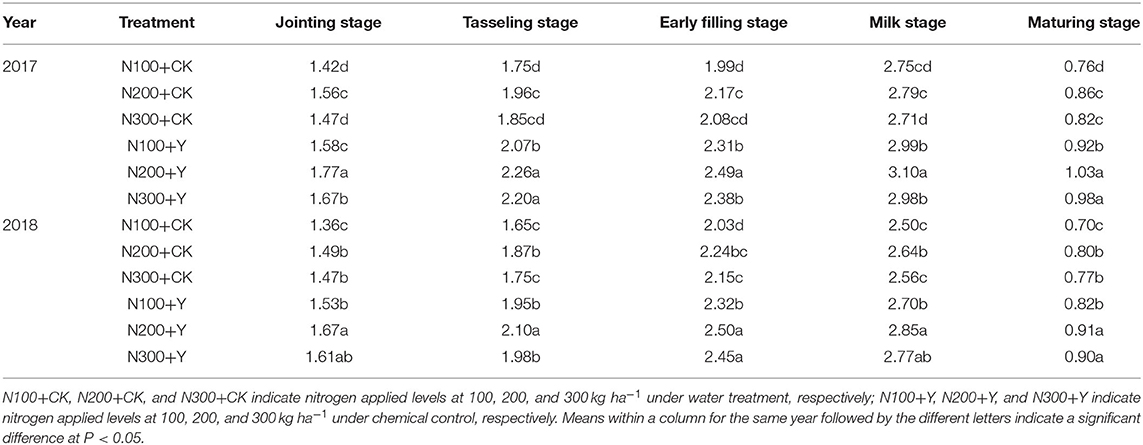
Table 1. Effects of chemical control and nitrogen fertilizers on root-bleeding sap rate (μg h−1 plant−1) during the maize growing period in 2017 and 2018.
The delivery rate of free amino acids in root-bleeding sap was influenced by chemical control and nitrogen fertilizer, which decreased after the jointing stage in maize (Table 2). At the same N levels, chemical control increased the delivery rate of Ser, Glu, Gly, Ala, Val, Lys, Met, Arg, and Leu with an average augment of ≈11.45–19.04% than water treatment at the tasseling stage in both years, which was consistent at different growth stages. Under the same chemical treatment, the free amino acid delivery rate obtained the highest value under N200 treatment, which showed an average augment of 6.54–15.04% and of 4.15–6.97% compared with N100 and N300 nitrogen rates in both years. From the analysis of synthetic effect, the delivery rate of free amino acids in root-bleeding sap was optimal in N200 application under chemical control.
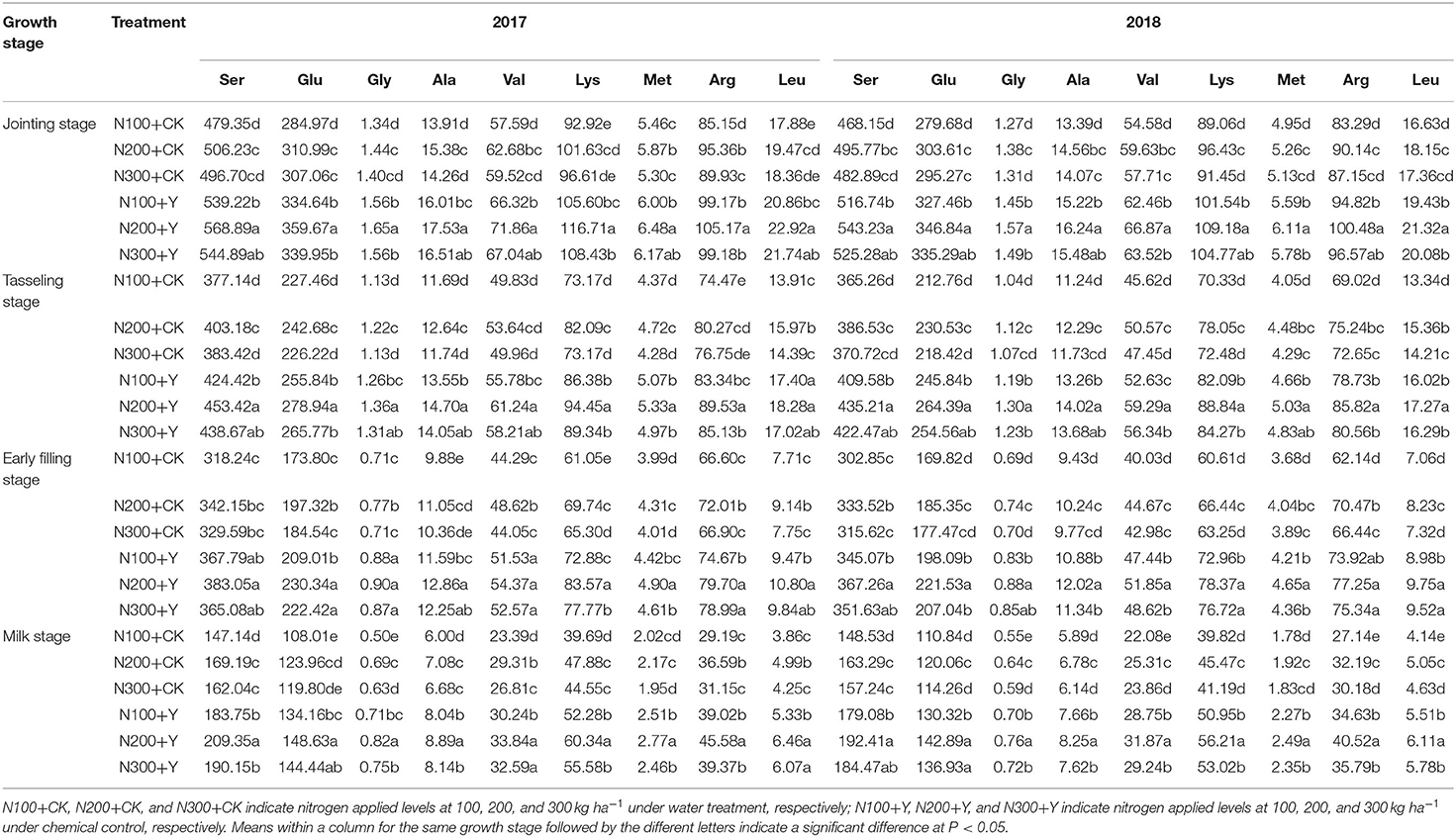
Table 2. Effects of chemical control and nitrogen fertilizers on amino acids concentrations (μg h−1 plant−1) in root-bleeding sap during the maize growing period in 2017 and 2018.
A similar change trend was observed in the mineral nutrient concentrations in bleeding sap during the maize growing period in 2017 and 2018 (Table 3). The mineral nutrient concentrations were significantly affected by chemical control and nitrogen fertilizer. The delivery rate of mineral nutrients first increased and then decreased with the increase of nitrogen application under the same chemical treatment. At the same N levels, chemical control obviously increased the delivery rate of mineral nutrients at different growth stages. From the analysis of synthetic effect, the delivery rate of mineral nutrients in root-bleeding sap was optimal in N200 application under chemical control.
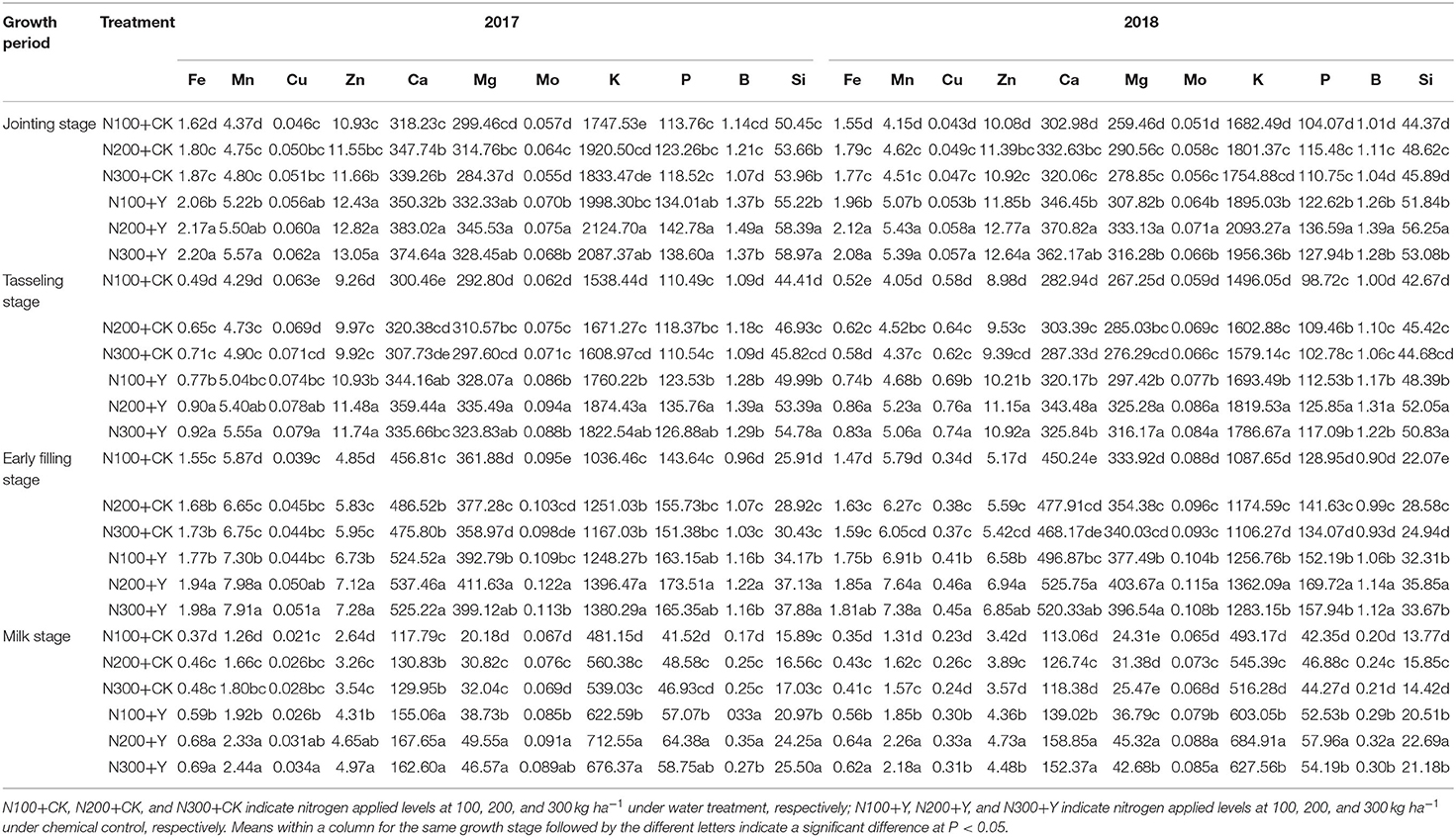
Table 3. Effects of chemical control and nitrogen fertilizers on mineral nutrients concentrations (μg h−1 plant−1) in root-bleeding sap during the maize growing period in 2017 and 2018.
P and K Accumulation and Translocation
Changes between the P and K accumulation in maize plants followed similar trends; both P and K increased gradually from the jointing stage to thewe maturing stage (Table 4). Chemical control and N fertilization level exhibited a marked influence on P and K accumulation amount during the maize growing period in both years. At the same N levels, chemical control increased P accumulation amount with an average augment of 4.48, 15.34, 22.07, 23.52, and 24.32% and K accumulation amount with an average augment of 6.30, 14.43, 17.60, 18.94, and 19.55% from the jointing stage to the maturing stage in 2017 and 2018. Under both water and chemical control conditions, P and K accumulation amount increased by increasing the N level from N100 to N300, but there was no significant difference between N200 and N300 treatments in both years. Compared with N100, N200 and N300 treatments increased P and K accumulation amount with an average augment of 22.41 and 24.26%, respectively.

Table 4. Effects of chemical control and nitrogen fertilizers on P and K accumulation (kg ha−1) during the maize growing period in 2017 and 2018.
Changes in the proportion of P and K accumulation in maize plants during various growth stages seemed to follow similar trends (Table 5). Proportions of P and K accumulation had a higher value at emerging (VE) —jointing (JT) and JT—tasseling (TS) stages and decreased gradually from TS—early-filling (EF) to milk (MK)—maturing (MT) stage. The proportions of P and K accumulation were significantly affected by chemical control and N fertilization level. At the same N levels, chemical control increased the proportions of P and K accumulation at TS-EF, EF-MK, and MK-MT stages, while the proportions decreased at the VE-JT stage and remained relatively constant at the JT-TS stage in 2017 and 2018. Under both water and chemical control conditions, N supply significantly increased the proportions of P and K accumulation. However, there was no significant difference between N200 and N300 treatments, and the highest proportions were obtained under N200 treatment at EF-MK and MK-MT stages in both years.
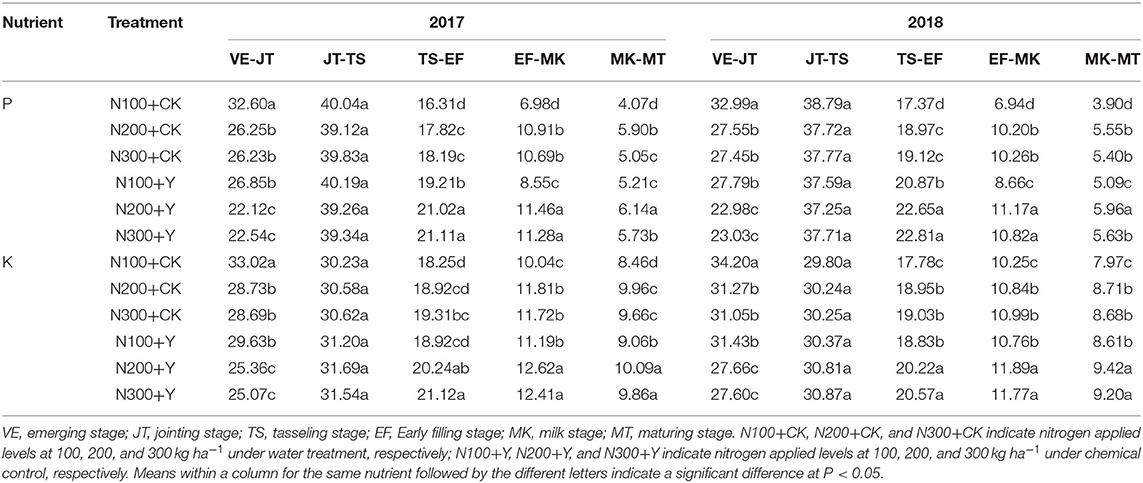
Table 5. Effects of chemical control and nitrogen fertilizers on the proportion of P and K accumulation (%) at different maize growing stages in 2017 and 2018.
Chemical control and nitrogen fertilizer significantly influenced the nutrient (P and K) translocation and contribution, including the vegetative organ nutrient content at the silking stage (VCS), the vegetative organ nutrient content at the maturing stage (VCM), and the grain nutrient content at the maturing stage (GCM), the nutrient translocation amount of pre-silking (TAE), the nutrient translocation rate of pre-silking (TRE), the contribution rate of nutrient translocation amount of pre-silking (CTAE), the nutrient accumulation amount of post-silking (AAT), and the contribution rate of nutrient accumulation amount of post-silking (CAAT) (Table 6). At the same N levels, VCS, VCM, GCM, TAE, AAT, and CAAT of P and K in maize plants under chemical control were markedly higher than those under water treatment. In contrast, TRE and CTAE of P and K in maize plants under chemical control were markedly lower than those under water treatment. Under both water and chemical control conditions, VCS, VCM, GCM, and TAE of P and K in maize plants were significantly increased by increasing N levels; however, TRE and CTAE were decreased. While N supply in general significantly increased AAT and CAAT of P and K in maize plants, there is no significant difference between N200 and N300 treatments, and the highest values were obtained under N200 treatment in both years.
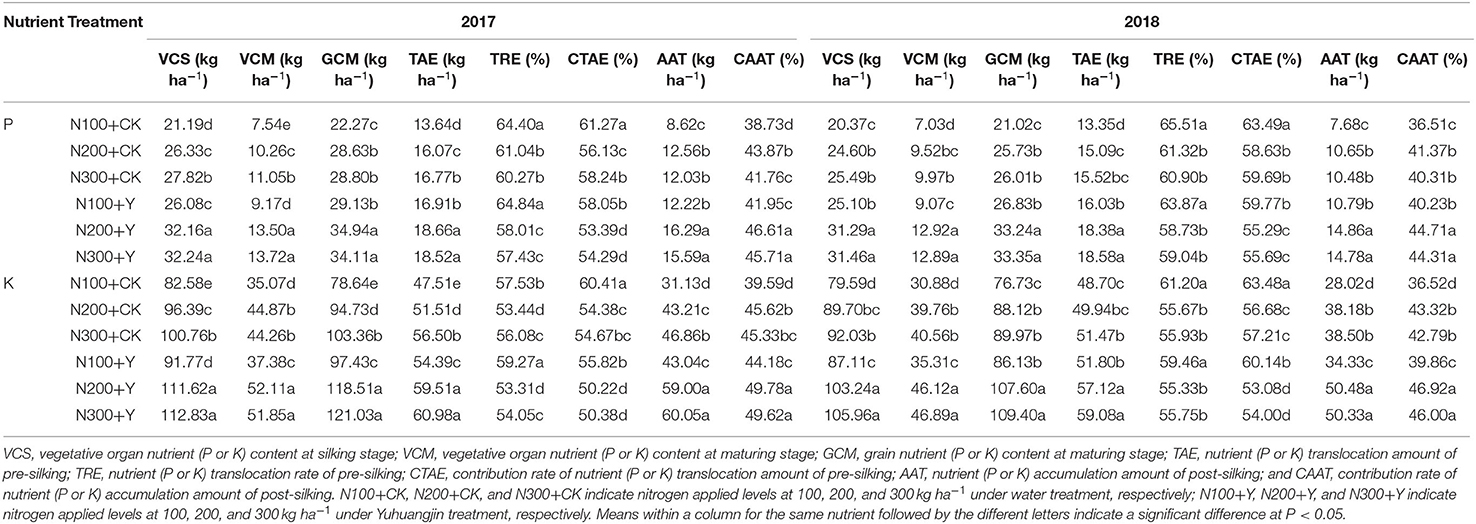
Table 6. Effects of chemical control and nitrogen fertilizers on maize nutrient (P and K) translocation and contribution during the maize growing period 2017 and 2018.
RuBPCase and PEPCase Activities in Leaf
Chemical control and N fertilization level exhibited a marked influence on RuBPCase activity in leaves during the maize growing period in 2017 and 2018 (Figure 2). At the same N levels, chemical control increased RuBPCase activity with an average augment of 12.45, 12.91, 11.03, and 13.02% from the jointing stage to the milk stage in 2017 and 2018, respectively. Under both water and chemical control conditions, RuBPCase activity increased with an average augment of 6.78% by increasing the N supply level from N100 to N200 in both years, but further increasing the N supply level from N200 to N300 decreased RuBPCase activity at different stages. From the analysis of synthetic effect, RuBPCase activity in maize leaf was optimal in N200 application under chemical control.

Figure 2. Effects of chemical control and nitrogen fertilizers on RuBPCase and PEPCase activities in ear leaf during the maize growing period in 2017 and 2018. N100+CK, N200+CK, and N300+CK indicate nitrogen applied levels at 100, 200, and 300 kg ha−1 under water treatment, respectively; N100+Y, N200+Y, and N300+Y indicate nitrogen applied levels at 100, 200, and 300 kg ha−1 under chemical control, respectively. Error bars indicate the value of standard error. Different letters within a growth stage indicate a significant difference at P < 0.05.
A similar trend was also observed for PEPCase activity in maize leaf, and the activity was significantly affected by chemical control and N fertilization levels (Figure 2). At the same N levels, chemical control increased PEPCase activity with an average augment of 15.46, 11.98, 15.13, and 17.43% from the jointing stage to the milk stage in 2017 and 2018, respectively. Under both water and chemical control conditions, PEPCase activity under N200 treatment was higher than those under N100 and N300 treatments, with an average augment of 7.87 and 4.46% at different stages, respectively. From the analysis of synthetic effect, PEPCase activity in maize leaf was optimal in N200 application under chemical control.
NR and GS Activities in Leaf
Chemical control and N fertilization level exhibited a marked influence on NR and GS activities in leaves during the maize growing period in 2017 and 2018 (Figure 3). At the same N levels, chemical control increased NR activity with an average augment of 18.23, 17.11, 14.32, and 14.71% and increased GS activity with an average augment of 20.28, 24.12, 17.41, and 25.69% from the jointing stage to the milk stage in both years, respectively. Under water and chemical control conditions, NR and GS activities were significantly increased by increasing the N level from N100 to N200, but further increasing the N supply level from N200 to N300 caused a decrease in NR and GS activities at different stages. From the analysis of synthetical effect, NR and GS activities in maize leaf were optimal in N200 application under chemical control.
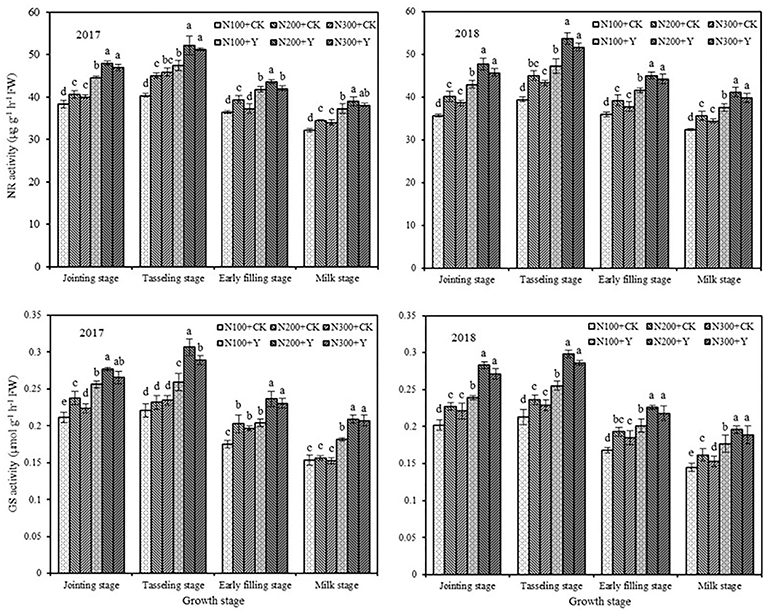
Figure 3. Effects of chemical control and nitrogen fertilizers on NR and GS activities in ear leaf during the maize growing period in 2017 and 2018. N100+CK, N200+CK, and N300+CK indicate nitrogen applied levels at 100, 200, and 300 kg ha−1 under water treatment, respectively; N100+Y, N200+Y, and N300+Y indicate nitrogen applied levels at 100, 200, and 300 kg ha−1 under chemical control, respectively. Error bars indicate the value of standard error. Different letters within a growth stage indicate a significant difference at P < 0.05.
N Metabolism Enzyme Activity in Grain
Chemical control and N fertilization level exerted a marked effect on grain GS, GDH, and GPT activities from 10 to 30 days after silking in 2017 and 2018 (Figure 4). Of these, GS and GDH activities increased between 10 and 20 days after silking and then decreased until 30 days after silking. However, GPT activity fluctuated with grain growth, which was highest and lowest at 25 and 30 days after silking, respectively. At the same N levels, chemical control increased GS, GDH, and GPT activities with an average augment of 15.22, 12.76, and 14.21% from 10 to 30 days after silking in both years, respectively. Under both water and chemical control conditions, GS, GDH, and GPT activities in grain were significantly increased by increasing the N supply level from N100 to N200 in both years, but further increasing the N supply level from N200 to N300 caused a slight decrease in grain N metabolism enzyme activities. From the analysis of synthetic effect, N metabolism enzyme activities in grain were optimal in N200 application under chemical control.
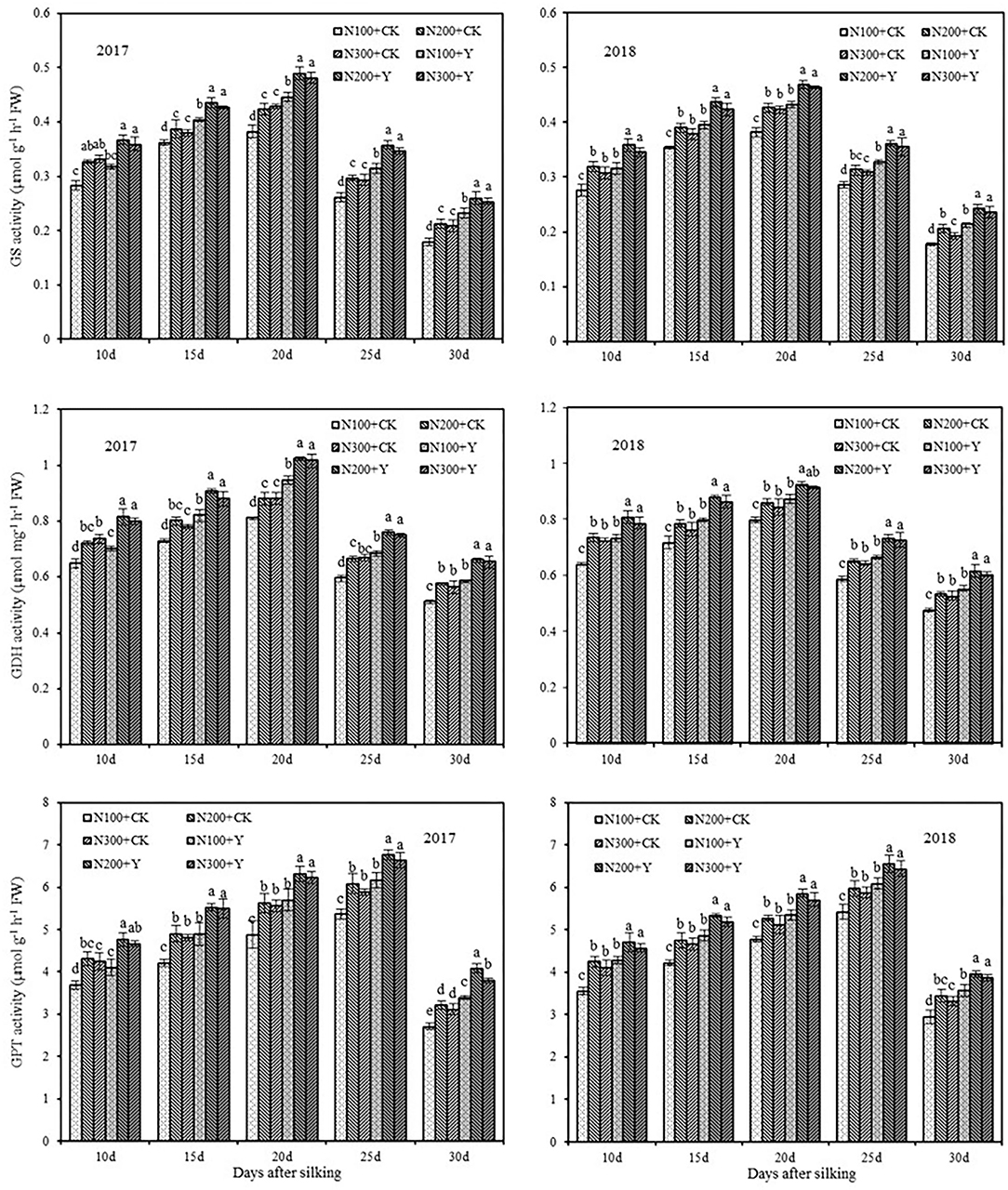
Figure 4. Effects of chemical control and nitrogen fertilizers on GS, GDH, and GPT activities in grain from 10 to 30 days after silking in 2017 and 2018. N100+CK, N200+CK, and N300+CK indicate nitrogen applied levels at 100, 200, and 300 kg ha−1 under water treatment, respectively; N100+Y, N200+Y, and N300+Y indicate nitrogen applied levels at 100, 200, and 300 kg ha−1 under chemical control, respectively. Error bars indicate the value of standard error. Different letters within a growth stage indicate a significant difference at P < 0.05.
Nutrients Concentrations in Grain
At the same N levels, chemical control significantly increased crude protein, lysine, sucrose, and soluble sugar concentrations of maize compared with water treatment in 2017 and 2018 (Table 7). Crude protein and lysine concentrations were significantly increased by increasing the N supply level from N100 to N200, but further increasing the N supply level from N200 to N300 caused a significant decrease in 2017 and a slight decrease in 2018. Similar trends were also observed for sucrose and soluble sugar concentrations of maize grain. Crude fat and starch concentrations were unaffected by chemical control and N fertilization level. The results show that nutrient concentrations in maize grain were optimal in N200 application under chemical control.
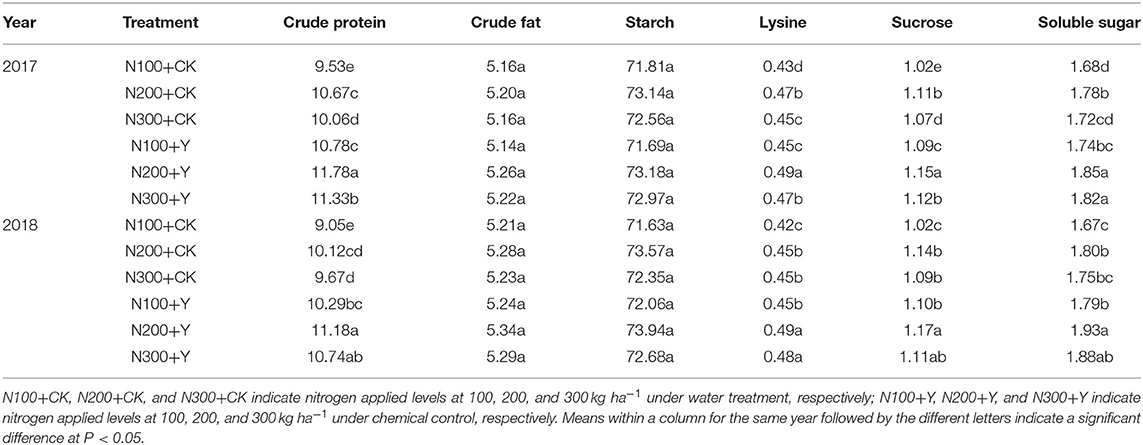
Table 7. Effects of chemical control and nitrogen fertilizers on grain nutrients concentrations (%) of maize during maize growing period 2017 and 2018.
Yield and Yield Components
Chemical control and N fertilization level exhibited a marked influence on yield and yield components of maize in 2017 and 2018 (Table 8). Chemical control significantly increased the number of grains per ear and 1,000-grain weight compared with maize under water treatment in 2017 and 2018. Grain number per ear and 1,000-grain weight significantly increased by increasing the N supply level from N100 to N200, but further increasing the N supply level from N200 to N300 caused a slight decrease in 2017 and 2018. The highest grain yields were obtained from the N200 application under chemical control in 2017 and 2018.

Table 8. Effects of chemical control and nitrogen fertilizers on yield and yield components of maize during the maize growing period 2017 and 2018.
Correlation Analysis
As shown in Figure 5, correlation analysis indicated that grain yield was positively correlated with the rate of root-bleeding sap, the delivery rate of amino acids and mineral nutrients in the bleeding sap, and CAAT of P and K. Besides, the CAAT of P and K were positively correlated with the rate of root-bleeding sap.

Figure 5. Correlation analysis of root-bleeding sap, nutrient contribution, and grain yield (values are the average in both years). CAAT, contribution rate of nutrient (P or K) accumulation amount post-silking.
Discussion
The root system is an essential source for uptake of water and nutrients, and its physiological activity is closely correlated to the development of the plant's parts above ground and the yield formation of crops (Yang et al., 2004; Fan et al., 2021). Root-bleeding sap reflects the capacity of roots to uptake water and nutrients, and it represents the physiological activity of the root system (Ansari et al., 2004; Wang P. et al., 2019). It has been found that root growth is closely associated with root-bleeding sap rate. The reduction of root quality in high-density planting seriously affects yield formation (Yu et al., 2019; Liu Z. et al., 2021). A balanced application of nitrogen can enhance root activity by supplying nutrients to form a robust root system (Wang H. et al., 2019). Equally, chemical control can optimize root morphological construction and improve the absorption ability of the root system (Lin et al., 2019).
In this study, N200 application in combination with chemical control significantly enhanced the rate of root-bleeding sap to enhance the strength of root activity. The nutrient concentrations in root-bleeding sap are closely associated with the absorption and transformation capacity of the root system, and its variation reflects the interaction intensity of nutrients in the aboveground and underground plant parts (Nishanth and Biswas, 2008). The xylem sap can transport nutrients upward to the aboveground tissues. The nutrient concentrations in root-bleeding sap are generally recognized as indicators of the plant's nutrient status (Ansari et al., 2004). Amino acids are essential for maintaining plant growth and, when contained in root-bleeding sap, promote root growth (Zheng et al., 2020). Mineral nutrient concentration is considered a primary factor for plant growth and grain yield. The delivery rate of mineral nutrients primarily depends on the root physiological activity and the nutrient concentrations across the root zone (Liang et al., 2020). High-density planting reduces root physiological activity and intensifies the depletion of nutrients in the root zone, resulting in the reduction of free amino acids and mineral nutrient concentrations (Yu et al., 2012; Liang et al., 2020). The content of free amino acids varied significantly with different nitrogen nutrient levels. It is believed that the delivery rate of free amino acids in root-bleeding sap increases with an increasing rate of nitrogen application (Li et al., 2009). In the present study, we found that N200 application combined with chemical control increased the delivery rate of amino acids and mineral nutrients in root-bleeding sap. The proper cultivation measure can improve the capacity of roots to absorb, synthesize, and transport carbohydrates, auxin, and other substances, thereby promoting root activity and root growth (Wang H. et al., 2019). The increase in root activity and its capacity for water and nutrients could lay the foundation for the increase in maize yield under high-density planting.
Nutrient absorption and accumulation are the basis of crop yield formation, and it directly affects the growth process of crops (Wu et al., 2018; Gorlach et al., 2021). Nutrient absorption in maize increases with plant growth. Sufficient nutrient supply during the growth period is the key to obtaining a high maize yield (Ray et al., 2020). Phosphorus and potassium are essential macronutrient elements for maize growth, which play an important role in the yield potential (Wu et al., 2015; Zhan et al., 2016). Nitrogen fertilizer is recognized to be an important factor affecting nutrient accumulation and transportation in addition to chemical control, which also impacts plant nutrient absorption capability (Van Oosten et al., 2019; Ray et al., 2020). In the present study, chemical control increased P and K accumulation amounts at different N levels. P and K accumulation amount increased with increasing level of N application, but the differences between N200 and N300 treatments were not significant. The nutrient accumulation by plants during different growth stages may impact crop yield. It is believed that the high nutrient absorption of N, P, and K in the middle growth stage of crops can promote pre-anthesis non-structural carbohydrate (NSC) reserves in the stem and accordingly enhance grain sink strength during grain filling (Fu et al., 2011; Li W. H. et al., 2012). Liu et al. (2019) considered that the P and K nutrient absorption in the late growth stage played an important role in improving maize production. In the present study, chemical control and nitrogen fertilizer greatly influenced the proportion of P and K accumulation during different growth stages in maize plants. Similarly, chemical control significantly increased the proportion of P and K accumulation during different growth stages except for the VE-JT and JT-TS stages. The proportion of P and K accumulation after the tasseling stage was obviously increased with increasing levels of N application. Chemical control and nitrogen fertilizer application substantially improved the CAAT of P and K in maize plants, and the highest CAAT of P and K were recorded under N200 application in combination with chemical control. The above results indicate that chemical control and nitrogen fertilizers can improve nutrient accumulation in maize after tasseling and increase the transfer of nutrients from vegetative organs to grains, consequently providing a material basis for yield formation. This result is similar to the study by Ray et al. (2020), which found that appropriate nutrient accumulation and translocation after silking created good conditions for maintaining the supply of nutrients to the grains, resulting in increased yields.
Carbon and nitrogen metabolism determines the level of crop production and function to provide the main energy and basic nutrients for plants (Cui et al., 2019). RuBPCase, PEPCase, NR, and GS are key enzymes involved in carbon and nitrogen metabolism in plants. In the present study, chemical control combined with N200 treatment increased RuBPCase, PEPCase, NR, and GS activities, leading to more assimilate accumulation and higher grain yield (Cheng et al., 2019; Yang et al., 2020). The plants maintained a high carbon and nitrogen metabolism and nutrient accumulation, which was the basis for assimilate accumulation in the grains. Main enzymes such as GS, GPT, and GDH are involved in the nitrogen metabolism in grains, and their activities directly affect the synthesis of amino acids and protein in grains (Wang et al., 2016). The N200 application, in combination with chemical control, significantly increased amino acid and protein content in grains, which in turn increased GS, GPT, and GDH activities. Chemical control and N200 treatments also increased the sucrose and soluble sugar contents of grains. This may be due to its association with higher sucrose metabolism and key enzyme activities (Kaur et al., 2018).
Increasing planting density is one of the important practices to increase maize yield per unit area in agricultural production (Tang et al., 2018). However, high-density planting intensifies the competition for light, nutrients, moisture, and space between maize plants, which restricts the growth of shoot and root systems, resulting in reduced crop yield (Rossini et al., 2011). The root system is the crop organ responsible for the uptake of nutrients, and a higher root activity enhances the nutrient absorption capacity in the root system (Yang et al., 2004). In the present study, the rate of root-bleeding sap was positively correlated with the contribution rate of nutrient (P or K) accumulation amount post-silking. It showed that the enhancement of root activity might be an effective method to develop the absorption and utilization capacity of P and K. Maintaining a relatively high level of root activity is an important approach to improving maize production. Niu et al. (2020) showed that increased root activity ensured the availability of soil nutrients and boosted photosynthetic capacity and biomass production, which are critical for grain filling and yield formation. In the present study, the grain yield was positively correlated with the rate of root-bleeding sap, the delivery rate of amino acids and mineral nutrients in bleeding sap, and the CAAT of P and K. It further confirmed that maintaining higher root activity and absorption and utilization capacity of P and K are the important approaches to obtaining high yields. Establishing a well-developed root system and efficient plant population can promote photosynthate production and nutrient accumulation and improve phosphorus and potassium distribution ratios after silking. Excessive nutrient transfer after silking usually affects the photosynthesis in leaves at a later growth stage, resulting in acceleration of leaf and root senescence and limiting yield improvement. However, deficient nutrient transfer after silking is harmful to grain filling, making it difficult to achieve a high yield. Therefore, appropriate cultivation methods can coordinate nutrient transfer and nutrient accumulation after silking and optimize the source-sink relationship, which plays an important role in improving yield. Our study on maize cultivation in Northeast China indicated that N200 combined with chemical control could optimize P and K absorption and translocation in the later growth stage by increasing root activity, thereby improving grain yield and quality.
Conclusion
N200 application in combination with chemical control significantly increased the root-bleeding sap rate, amino acid delivery rate, and mineral nutrient delivery rate. It promoted the accumulation and translocation of P and K nutrients after the tasseling stage, and as a result, it provided a material basis for yield formation. Moreover, N200 combined with chemical control obviously enhanced enzyme activities of carbon and nitrogen metabolism in leaves, increased nitrogen metabolism enzyme activities in grains during the early and middle grain filling stage, and improved amino acid and protein content in grains, thereby increasing the grain yield and quality of maize in high-density planting. The schematic representation indicates that nitrogen fertilizers and chemical control increased the grain yield and quality by optimizing root-bleeding sap, nutrient accumulation and transport, photosynthesis, and N metabolism in maize under high-density planting (Figure 6). Therefore, attention should be paid to promoting nitrogen fertilizer and chemical control management in high-density planting of maize in future agricultural production in Northeast China as it plays a crucial role in improving maize yield and quality.
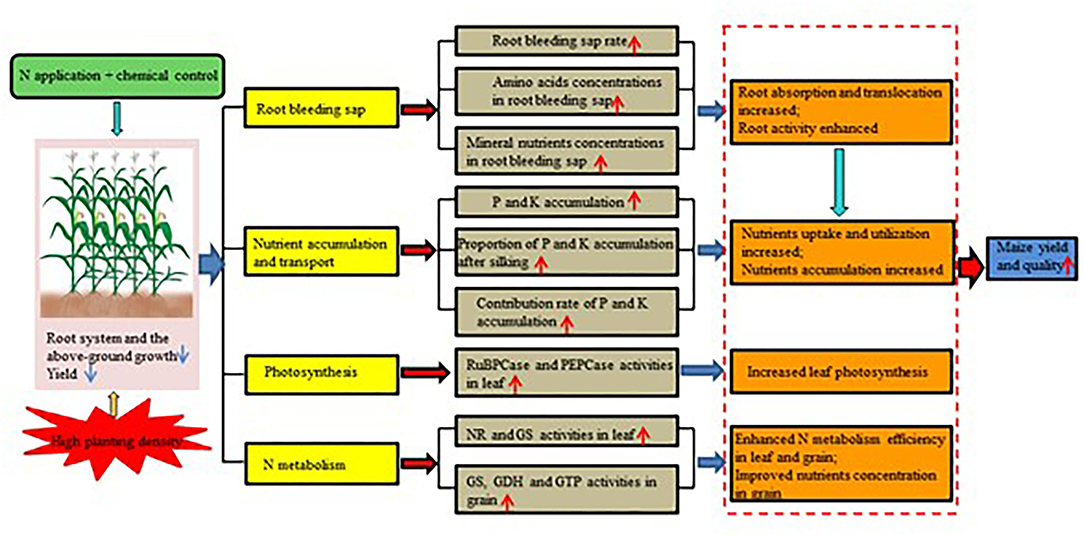
Figure 6. The schematic representation of nitrogen fertilizers and chemical control regulated maize yield. The red arrows (↑) and the blue arrows (↓) represent the positive and passive roles of treatment, respectively.
Data Availability Statement
The original contributions presented in the study are included in the article/supplementary material, further inquiries can be directed to the corresponding author/s.
Author Contributions
XL and LZ collected and analyzed the samples and wrote the manuscript. YY, CQ, and CoL contributed to the writing and editing of the manuscript. SW, CaL, and WG contributed to the design of the work and analysis and revised the manuscript. All authors read and approved the article.
Funding
This study was financially supported by the National Key Research and Development Program of China (2016YFD0300103) and the National Modern Agriculture Industry Technology System (CARS-02-12).
Conflict of Interest
The authors declare that the research was conducted in the absence of any commercial or financial relationships that could be construed as a potential conflict of interest.
Publisher's Note
All claims expressed in this article are solely those of the authors and do not necessarily represent those of their affiliated organizations, or those of the publisher, the editors and the reviewers. Any product that may be evaluated in this article, or claim that may be made by its manufacturer, is not guaranteed or endorsed by the publisher.
References
Ansari, T. H., Yamamoto, Y., Yoshida, T., Sakagami, K., and Miyazaki, A. (2004). Relation between bleeding rate during panicle formation stage and sink size in rice plant. Soil Sci. Plant Nutr. 50, 57–66. doi: 10.1080/00380768.2004.10408452
AOAC (1975). Official Methods of Analysis, 12th Edn. Washington, DC: Association of Official Agricultural Chemists.
AOAC (1984). Official Methods of Analysis, 14th Edn. Arlington, VA: Association of Official Analytical Chemists.
Arnozis, P. A., Nelemans, J. A., and Findenegg, G. R. (1988). Phosphoenolpyruvate carboxylase activity in plants grown with either NO or NH as inorganic nitrogen source. J. Plant Physiol. 132, 23–27. doi: 10.1016/S0176-1617(88)80177-9
Boros, D., Slominski, B. A., Guenter, W., Campbell, L. D., and Jones, O. (2004). Wheat by-products in poultry nutrition. Part II. Nutritive value of wheat screenings, bakery by-products and wheat mill run and their improved utilization by enzyme supplementation. Can. J. Anim. Sci. 84, 429–435. doi: 10.4141/A03-113
Canovas, F. M., Canton, F. R., Gallardo, F., Garciagutierrez, A., and Devicente, A. (1991). Accumulation of glutamine-synthetase during early development of maritime pine (Pinus pinaster) seedlings. Planta 185, 372–378. doi: 10.1007/BF00201059
Chen, P. P., Gu, X. B., Li, Y. N., Qiao, L. R., Li, Y. P., Fang, H., et al. (2022). Effects of residual film on maize root distribution, yield and water use efficiency in Northwest China. Agric. Water Manag. 260, 107289. doi: 10.1016/j.agwat.2021.107289
Cheng, Y. Y., Wang, Y., Han, Y. L., Li, D. Y., Zhang, Z. K., Zhu, X. Q., et al. (2019). The stimulatory effects of nanochitin whisker on carbon and nitrogen metabolism and on the enhancement of grain yield and crude protein of winter wheat. Molecules 24, 1752. doi: 10.3390/molecules24091752
Cui, G. C., Zhang, Y., Zhang, W. J., Lang, D. Y., Zhang, X. J., Li, Z. X., et al. (2019). Response of carbon and nitrogen metabolism and secondary metabolites to drought stress and salt stress in plants. J. Plant Biol. 62, 387–399. doi: 10.1007/s12374-019-0257-1
Fan, Y. F., Gao, J. L., Sun, J. Y., Liu, J., Su, Z. J., Wang, Z. G., et al. (2021). Effects of straw returning and potassium fertilizer application on root characteristics and yield of spring maize in China inner Mongolia. Agron. J. 113, 4369–4385. doi: 10.1002/agj2.20742
Fu, J., Huang, Z. H., Wang, Z. Q., Yang, J. C., and Zhang, J. H. (2011). Pre-anthesis non-structural carbohydrate reserve in the stem enhances the sink strength of inferior spikelets during grain filling of rice. Field Crops Res. 123, 170–182. doi: 10.1016/j.fcr.2011.05.015
Gao, J., Lei, M., Yang, L. J., Wang, P., Tao, H. B., and Huang, S. B. (2021). Reduced row spacing improved yield by optimizing root distribution in maize. Eur. J. Agron. 127, 126291. doi: 10.1016/j.eja.2021.126291
Gorlach, B. M., Henningsen, J. N., Mackens, J. T., and Muhling, K. H. (2021). Evaluation of maize growth following early season foliar P supply of various fertilizer formulations and in relation to nutritional status. Agronomy 11, 727. doi: 10.3390/agronomy11040727
Hutsch, B. W., and Schubert, S. (2017). Maize harvest index and water use efficiency can be improved by inhibition of gibberellin biosynthesis. J. Agron. Crop Sci. 204, 209–218. doi: 10.1111/jac.12250
Iqbal, S., Akhtar, J., Naz, T., Riaz, U., Hussain, S., Mazhar, Z., et al. (2020). Root morphological adjustments of crops to improve nutrient use efficiency in limited environments. Commun. Soil Sci. Plan. 51, 2452–2465. doi: 10.1080/00103624.2020.1836199
Kaur, M., Sharma, S., and Singh, D. (2018). Influence of selenium on carbohydrate accumulation in developing wheat grains. Commun. Soil Sci. Plan. 49, 1650–1659. doi: 10.1080/00103624.2018.1474903
Lewis, O. A. M., Watson, E. F., and Hewitt, E. J. (1982). Determination of nitrate reductase activity in barley leaves and roots. Ann. Bot. 49, 31–37. doi: 10.1093/oxfordjournals.aob.a086227
Li, G. H., Cheng, Q., Li, L., Lu, D. L., and Lu, W. P. (2021). N, P and K use efficiency and maize yield responses to fertilization modes and densities. J. Integr. Agric. 20, 78–86. doi: 10.1016/S2095-3119(20)63214-2
Li, G. H., Wang, L. F., Li, L., Lu, D. L., and Lu, W. P. (2020). Effects of fertilizer management strategies on maize yield and nitrogen use efficiencies under different densities. Agron. J. 112, 368–381. doi: 10.1002/agj2.20075
Li, G. H., Zhao, B., Dong, S. T., Zhang, J. W., Liu, P., Ren, B. Z., et al. (2019). Morphological and physiological characteristics of maize roots in response to controlled-release urea under different soil moisture conditions. Agron. J. 111, 1849–1864. doi: 10.2134/agronj2018.08.0508
Li, H. W., Liu, L. J., Wang, Z. Q., Yang, J. C., and Zhang, J. H. (2012). Agronomic and physiological performance of high-yielding wheat and rice in the lower reaches of Yangtze River of China. Field Crops Res. 133, 119–129. doi: 10.1016/j.fcr.2012.04.005
Li, S. X., Wang, Z. H., Malhi, S. S., Li, S. Q., Gao, Y. J., and Tian, X. H. (2009). Nutrient and water management effects on crop production: and nutrient and water use efficiency in dryland areas of China. Adv. Agron. 102, 223–265. doi: 10.1016/S0065-2113(09)01007-4
Li, W. H., Hou, M. J., Cao, Y. S., Song, H., Shi, T. Y., Gao, X. W., et al. (2012). Determination of 20 free amino acids in asparagus tin by high-performance liquid chromatographic method after pre-column derivatization. Food Anal. Methods 5, 62–68. doi: 10.1007/s12161-011-9197-1
Liang, X. Y., Guo, F., Feng, Y., Zhang, J. L., Yang, S., Meng, J. J., et al. (2020). Single-seed sowing increased pod yield at a reduced seeding rate by improving root physiological state of Arachis hypogaea. J. Integr. Agric. 19, 1019–1032. doi: 10.1016/S2095-3119(19)62712-7
Lilley, R. M., and Walker, D. A. (1974). An improved spectrophotometric assay for ribulosebisphosphate carboxylase. BBA-Enzymology 358, 226–229. doi: 10.1016/0005-2744(74)90274-5
Lin, Y. R., Watts, D. B., Kloepper, J. W., Feng, Y. C., and Torbert, H. A. (2019). Influence of plant growth-promoting rhizobacteria on corn growth under drought stress. Commun. Soil Sci. Plan. 51, 250–264. doi: 10.1080/00103624.2019.1705329
Liu, A. H., and Ye, Z. C. (2020). “China Agriculture Yearbook” in China Statistical Yearbook (Beijing: China Agriculture Press), 373–402. (in Chinese).
Liu, H. R., Song, H. X., Liu, D. P., Guan, C. Y., Liu, Q., and Chen, S. Y. (2007). Dynamics changes of soluble sugar and free amino acid contents in stem and leaf of different oilseed rape varieties (in Chinese with English abstract). Acta Agri Boreali-occidentalis Sin. 16, 123–126. doi: 10.3969/j.issn.1004-1389.2007.01.029
Liu, K., Ma, B. L., Luan, L. M., and Li, C. H. (2011). Nitrogen, phosphorus, and potassium nutrient effects on grain filling and yield of high-yielding summer corn. J. Plant Nutr. 34, 1516–1531. doi: 10.1080/01904167.2011.585208
Liu, M. L., Wang, C., Wang, F. Y., and Xie, Y. J. (2019). Maize (Zea mays) growth and nutrient uptake following integrated improvement of vermicompost and humic acid fertilizer on coastal saline soil. Appl. Soil Ecol. 142, 147–154. doi: 10.1016/j.apsoil.2019.04.024
Liu, S. Q., Jian, S. L., Li, X. N., and Wang, Y. (2021). Wide-narrow row planting pattern increases root lodging resistance by adjusting root architecture and root physiological activity in maize (Zea mays L.) in Northeast China. Agriculture 11, 517. doi: 10.3390/agriculture11060517
Liu, Z., Ying, H., Chen, M., Liu, Z. T., Ying, H., Chen, M. Y., et al. (2021). Optimization of China's maize and soy production can ensure feed sufficiency at lower nitrogen and carbon footprints. Nat. Food 2, 426–433. doi: 10.1038/s43016-021-00300-1
Liu, Z., Zhu, K. L., Dong, S. T., Liu, P., Zhao, B., and Zhang, J. W. (2017). Effects of integrated agronomic practices management on root growth and development of summer maize. Eur. J. Agron. 84, 140–151. doi: 10.1016/j.eja.2016.12.006
Luo, N., Wang, X. Y., Hou, J. M., Wang, Y. Y., Wang, P., and Meng, Q. F. (2020). Agronomic optimal plant density for yield improvement in the major maize regions of China. Crop Sci. 60, 1580–1590. doi: 10.1002/csc2.20000
Murphy, J., and Riley, J. P. (1962). A modified single solution method for the determination of phosphate in natural waters. Anal. Chim. Acta 27, 31–36. doi: 10.1016/S0003-2670(00)88444-5
Nawaz, M., Ishaq, S., Ishaq, H., Khan, N., Iqbal, N., Ali, S., et al. (2020). Salicylic acid improves boron toxicity tolerance by modulating the physio-biochemical characteristics of maize (Zea mays L.) at an early growth stage. Agronomy 10, 2013. doi: 10.3390/agronomy10122013
Nishanth, D., and Biswas, D. R. (2008). Kinetics of phosphorus and potassium release from rock phosphate and waste mica enriched compost and their effect on yield and nutrient uptake by wheat (Triticum aestivum). Bioresour. Technol. 99, 3342–3353. doi: 10.1016/j.biortech.2007.08.025
Niu, L., Yan, Y. Y., Hou, P., Bai, W. B., Zhao, R. L., Wang, Y. H., et al. (2020). Influence of plastic film mulching and planting density on yield, leaf anatomy, and root characteristics of maize on the Loess Plateau. Crop J. 8, 548–564. doi: 10.1016/j.cj.2019.12.002
Noguchi, A., Kageyama, M., Shinmachi, F., Schmidhalter, U., and Hasegawa, I. (2005). Potential for using plant xylem sap to evaluate inorganic nutrient availability in soil—I. Influence of inorganic nutrients present in the rhizosphere on those in the xylem sap of Luffa cylindrica Roem. Soil Sci. Plant Nutr. 51, 333–341. doi: 10.1111/j.1747-0765.2005.tb00038.x
Palacios-Rojas, N., McCulley, L., Kaeppler, M., Titcomb, T. J., Gunaratna, N. S., Lopez-Ridaura, S., et al. (2020). Mining maize diversity and improving its nutritional aspects within agro-food systems. Compr. Rev. Food Sci. Food Sci. Food Saf. 19, 1809–1834. doi: 10.1111/1541-4337.12552
Ray, K., Banerjee, H., Dutta, S., Sarkar, S., Murrell, T. S., Singh, V. K., et al. (2020). Macronutrient management effects on nutrient accumulation, partitioning, remobilization, and yield of hybrid maize cultivars. Front. Plant Sci. 11:1307. doi: 10.3389/fpls.2020.01307
Reddy, Y. R., Ravi, D., Reddy, C. R., Prasad, K. V. S. V., Zaidi, P. H., Vinayan, M. T., et al. (2013). A note on the correlations between maize grain and maize stover quantitative and qualitative traits and the implications for whole maize plant optimization. Field Crops Res. 153, 63–69. doi: 10.1016/j.fcr.2013.06.013
Rossini, M. A., Maddonni, G. A., and Otegui, M. E. (2011). Inter-plant competition for resources in maize crops grown under contrasting nitrogen supply and density: variability in plant and ear growth. Field Crops Res. 121, 373–380. doi: 10.1016/j.fcr.2011.01.003
Shahzad, A. N., Fatima, A., Sarwar, N., Bashir, S., Rizwan, M., Qayyum, M. F., et al. (2017). Foliar application of potassium sulfate partially alleviates pre-anthesis drought-induced kernel abortion in maize. Int. J. Agric. Biol. 19, 495–501. doi: 10.17957/IJAB/15.0317
Shao, H., Xia, T. T., Wu, D. L., Chen, F. J., and Mi, G. H. (2018). Root growth and root system architecture of field-grown maize in response to high planting density. Plant Soil 430, 395–411. doi: 10.1007/s11104-018-3720-8
Stutts, L., Wang, Y., and Stapleton, A. E. (2018). Plant growth regulators ameliorate or exacerbate abiotic, biotic and combined stress interaction effects on Zea mays kernel weight with inbred-specific patterns. Environ. Exp. Bot. 147, 179–188. doi: 10.1016/j.envexpbot.2017.12.012
Tang, L. Y., Ma, W., Noor, M. A., Li, L. L., Hou, H. P., Zhang, X. Y., et al. (2018). Density resistance evaluation of maize varieties through new “Density-Yield Model” and quantification of varietal response to gradual planting density pressure. Sci. Rep. 8:17281. doi: 10.1038/s41598-018-35275-w
Van Oosten, M. J., Dell'Aversana, E., Ruggiero, A., Cirillo, V., Gibon, Y., Woodrow, P., et al. (2019). Omeprazole treatment enhances nitrogen use efficiency through increased nitrogen uptake and assimilation in corn. Front. Plant Sci. 10:1507. doi: 10.3389/fpls.2019.01507
Van, H. E. (1968). Direct microdetermination of sucrose. Anal. Biochem. 22, 280–283. doi: 10.1016/0003-2697(68)90317-5
Wang, C., and Ning, P. (2019). Post-silking phosphorus recycling and carbon partitioning in maize under low to high phosphorus inputs and their effects on grain yield. Front. Plant Sci. 10:784. doi: 10.3389/fpls.2019.00784
Wang, F., Gao, J. W., Liu, Y., Tian, Z. W., Muhammad, A., Zhang, Y. X., et al. (2016). Higher ammonium transamination capacity can alleviate glutamate inhibition on winter wheat (Triticum aestivum L.) root growth under high ammonium stress. PLoS ONE 11:e0160997. doi: 10.1371/journal.pone.0160997
Wang, H., Xu, R. R., Li, Y., Yang, L. Y., Shi, W., Liu, Y. J., et al. (2019). Enhance root-bleeding sap flow and root lodging resistance of maize under a combination of nitrogen strategies and farming practices. Agric. Water Manag. 224, 105742. doi: 10.1016/j.agwat.2019.105742
Wang, P., Wang, Z. K., Pan, Q. C., Sun, X. C., Chen, H., Chen, F. J., et al. (2019). Increased biomass accumulation in maize grown in mixed nitrogen supply is mediated by auxin synthesis. J. Exp. Bot. 70, 1859–1873. doi: 10.1093/jxb/erz047
Wolf, B. (1982). A comprehensive systems of leaf analysis and its use for diagnosing crop nutrients status. Commun. Soil Sci. Plant. 13, 1035–1059. doi: 10.1080/00103628209367332
Wu, H., Xiang, J., Zhang, Y. P., Zhang, Y. K., Peng, S. B., Chen, H. Z., et al. (2018). Effects ofpost-anthesis nitrogen uptake and translocation on photosynthetic production and rice yield. Sci. Rep. 8, 12891. doi: 10.1038/s41598-018-31267-y
Wu, L. Q., Cui, Z. L., Chen, X. P., Yue, S. C., Sun, Y. X., Zhao, R. F., et al. (2015). Change in phosphorus requirement with increasing grain yield for Chinese maize production. Field Crops Res. 180, 216–220. doi: 10.1016/j.fcr.2015.06.001
Xie, W. J., Wang, H. Y., Xia, J. B., and Yao, Z. G. (2011). Influence of N, P, and K application on Zea mays L. growth and Cu and Pb accumulation. Plant Soil Environ. 57, 128–134. doi: 10.17221/225/2010-PSE
Xu, C. L., Tao, H. B., Tian, B. J., Gao, Y. B., Ren, J. H., and Wang, P. (2016). Limited-irrigation improves water use efficiency and soil reservoir capacity through regulating root and canopy growth of winter wheat. Field Crops Res. 196, 268–275. doi: 10.1016/j.fcr.2016.07.009
Xu, L. Z., Niu, J. F., Li, C. J., and Zhang, F. S. (2009). Growth, nitrogen uptake and flow in maize plants affected by root growth restriction. J. Integr. Plant Biol. 51, 689–697. doi: 10.1111/j.1744-7909.2009.00843.x
Yang, C. M., Yang, L. Z., Yang, Y. X., and Zhu, O. Y. (2004). Rice root growth and nutrient uptake as influenced by organic manure in continuously and alternately flooded paddy soils. Agric. Water Manag. 70, 67–81. doi: 10.1016/j.agwat.2004.05.003
Yang, H., Gu, X. T., Ding, M. Q., Lu, W. P., and Lu, D. L. (2020). Weakened carbon and nitrogen metabolisms under post-silking heat stress reduce the yield and dry matter accumulation in waxy maize. J. Integr. Agric. 19, 78–88. doi: 10.1016/S2095-3119(19)62622-5
Yu, X. F., Zhang, Q., Gao, J. L., Wang, Z. G., Borjigin, Q., Hu, S. P., et al. (2019). Planting density tolerance of high-yielding maize and the mechanisms underlying yield improvement with subsoiling and increased planting density. Agronomy 9, 370. doi: 10.3390/agronomy9070370
Yu, X. M., Wang, B., Zhang, C. X., Xu, W. P., and He, J. J. (2012). Effect of root restriction on nitrogen levels and glutamine synthetase activity in “Kyoho” grapevines. Sci. Hortic. 137, 156–163. doi: 10.1016/j.scienta.2012.01.025
Zhan, A., Zou, C. Q., Ye, Y. L., Liu, Z. H., Cui, Z. L., and Chen, X. P. (2016). Estimating on-farm wheat yield response to potassium and potassium uptake requirement in China. Field Crops Res. 191, 13–19. doi: 10.1016/j.fcr.2016.04.001
Zhang, Q., Zhang, L. Z., Evers, J., Werf, W. V. D., Zhang, W. Q., and Duan, L. S. (2014). Maize yield and quality in response to plant density and application of a novel plant growth regulator. Field Crops Res. 164, 82–89. doi: 10.1016/j.fcr.2014.06.006
Zhang, Z., Yu, Z. W., Zhang, Y. L., and Shi, Y. (2021). Optimized nitrogen fertilizer application strategies under supplementary irrigation improved winter wheat (Triticum aestivum L.) yield and grain protein yield. PeerJ 9, e11467. doi: 10.7717/peerj.11467
Keywords: nitrogen fertilizer, chemical control, root bleeding sap, nutrient absorption, maize
Citation: Liu X, Zhang L, Yu Y, Qian C, Li C, Wei S, Li C and Gu W (2022) Nitrogen and Chemical Control Management Improve Yield and Quality in High-Density Planting of Maize by Promoting Root-Bleeding Sap and Nutrient Absorption. Front. Plant Sci. 13:754232. doi: 10.3389/fpls.2022.754232
Received: 06 August 2021; Accepted: 25 May 2022;
Published: 23 June 2022.
Edited by:
Ioannis Tokatlidis, Democritus University of Thrace, GreeceReviewed by:
Mingcai Zhang, China Agricultural University, ChinaDalei Lu, Yangzhou University, China
Copyright © 2022 Liu, Zhang, Yu, Qian, Li, Wei, Li and Gu. This is an open-access article distributed under the terms of the Creative Commons Attribution License (CC BY). The use, distribution or reproduction in other forums is permitted, provided the original author(s) and the copyright owner(s) are credited and that the original publication in this journal is cited, in accordance with accepted academic practice. No use, distribution or reproduction is permitted which does not comply with these terms.
*Correspondence: Caifeng Li, bGljYWlmZW5nQG5lYXUuZWR1LmNu; Wanrong Gu, d2Fucm9uZ2d1QG5lYXUuZWR1LmNu
 Xiaoming Liu1
Xiaoming Liu1 Shi Wei
Shi Wei Caifeng Li
Caifeng Li Wanrong Gu
Wanrong Gu